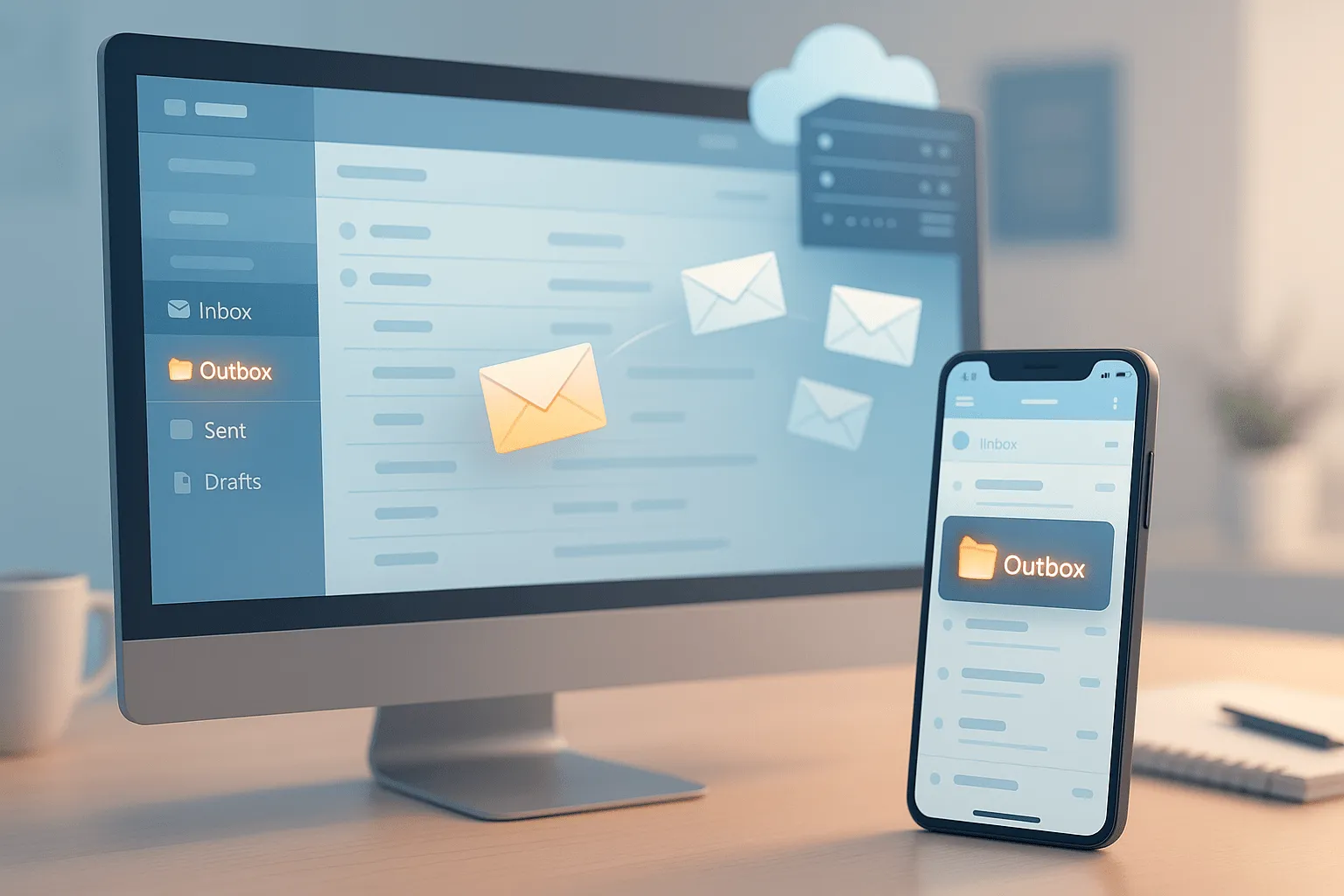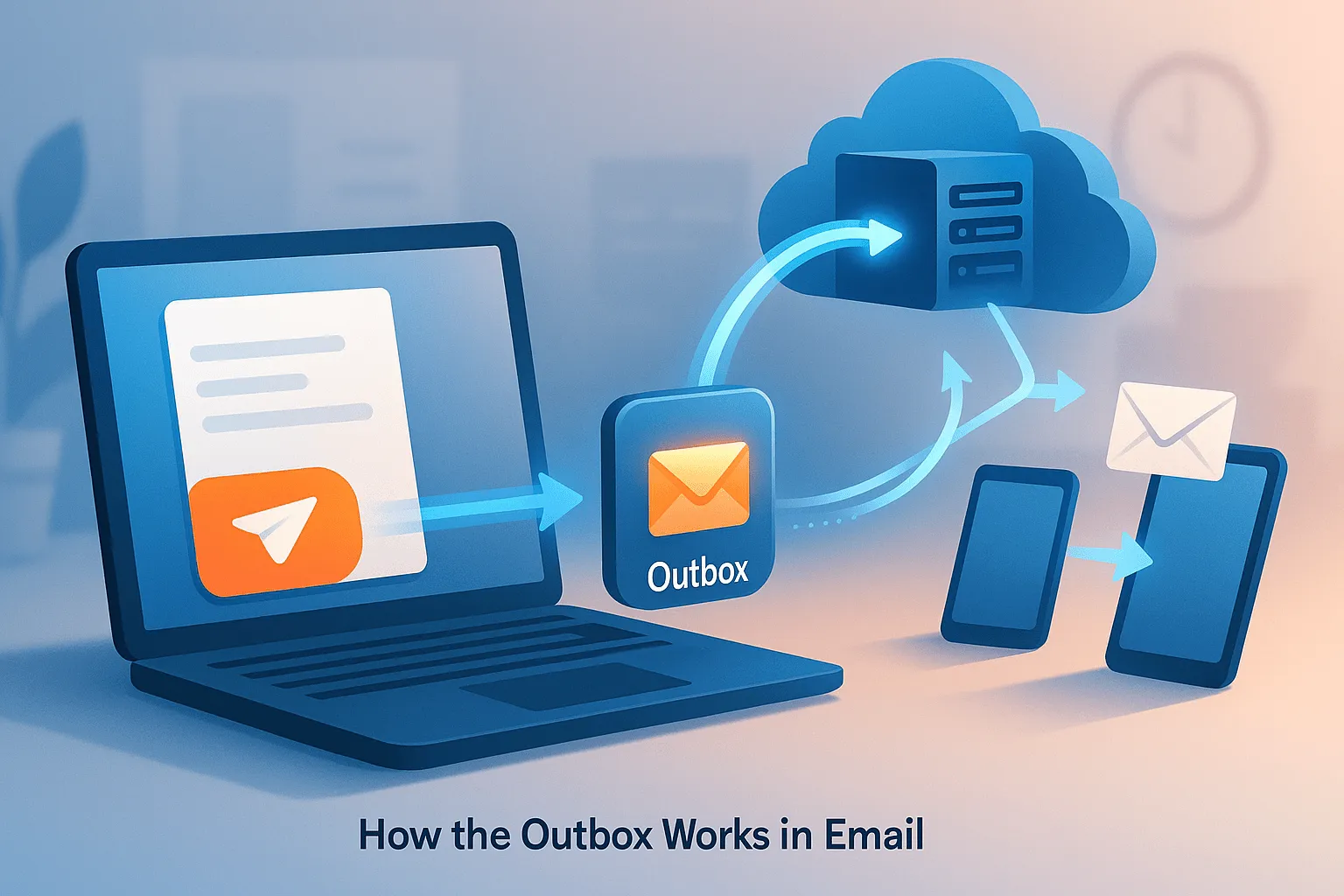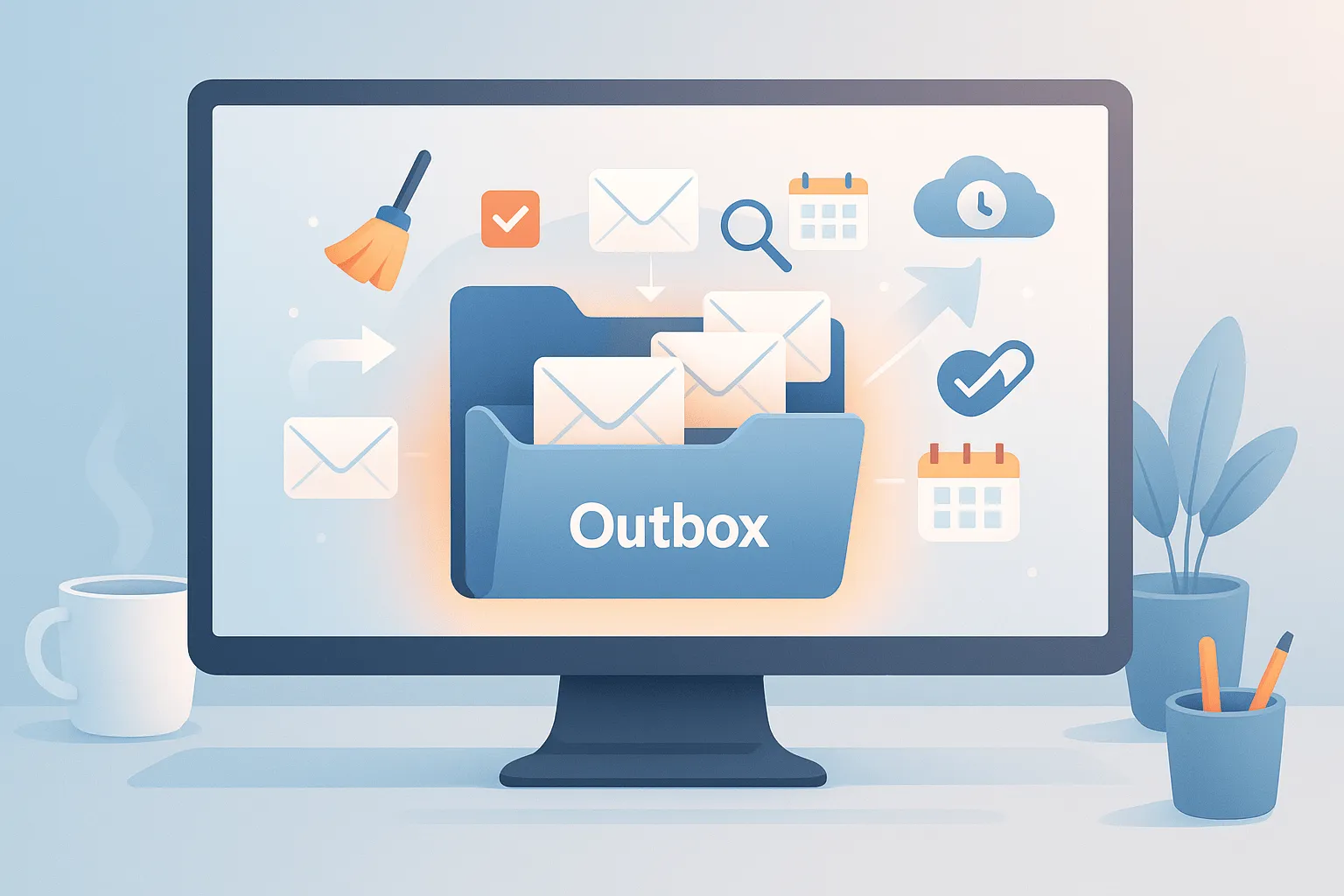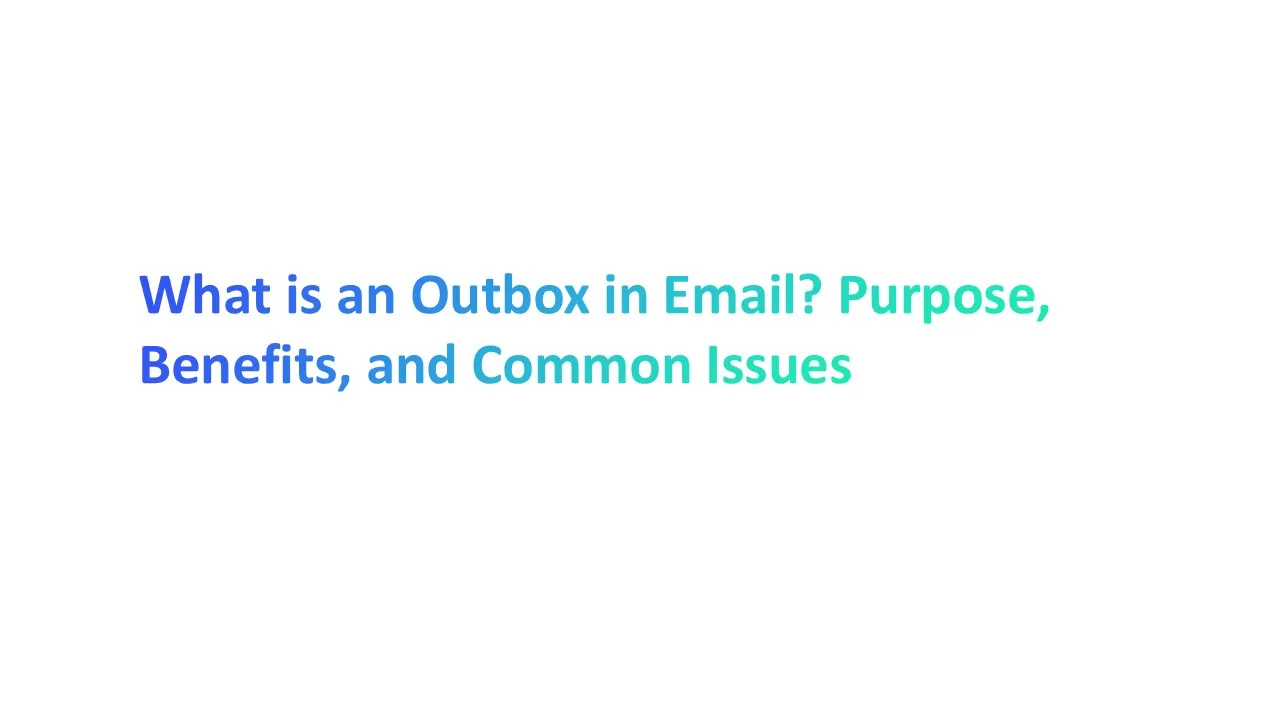Every email you send takes a quick pit stop before reaching its destination—and that pit stop is called the outbox.
According to Radicati Group, the average office worker sends 40+ emails per day, meaning the outbox is constantly at work. But why do messages sometimes stay there longer than expected?
In this article, you’ll learn what is an outbox in email, the benefits it offers, and the most common problems (with fixes) so your email communication stays smooth.
What is an Outbox in Email?

The outbox is a special folder in your email client that stores messages right after you click the send button. It’s a short stop before your email server delivers them to the recipient’s server.
Think of it as a safe spot for outgoing emails while your internet connection and email settings work together to send them successfully.
According to Statista, more than 347 billion email messages are sent daily, and almost all pass through an email outbox first.
Why emails remain in the outbox folder temporarily
Sometimes your messages don’t leave right away. Common reasons include:
- Slow or lost internet connection – Without a stable link, your email will remain in the outbox folder until connected.
- Large attachments – Big files take longer to upload to the server.
- Server issues – Problems on the email server or the recipient’s server can delay sending.
- Incorrect settings – Wrong SMTP or email settings can stop sending.
Quick Tip: Check your internet and connection, verify email settings, and remove large attachments if your outbox in email isn’t clearing.
How the Outbox Works in Email Clients

1. Compose Your Message
- You start by writing your email in the compose window of your email client. Add your text, attachments, and recipient details. The email is not yet in the outbox folder—it’s still in draft mode.
- Example: If you attach a large file, remember it might cause delays later in the process.
2. Click the Send Button
- Once you hit the send button, your email client moves the message to the outbox folder. This is the first step before the email travels to the email server.
- If your internet connection is weak or offline, the message will remain in the outbox until the connection is restored. “Think of it as the email getting in line to board the delivery train,” says a support guide from Outlook.
3. Stored in the Holding Area
- The outbox folder acts as a holding area for all outgoing emails waiting to be sent. Your email client connects to the server and sends the message to the recipient’s server.
- Once sent successfully, the email moves to your sent folder or sent items. If there are server issues, incorrect settings, or large attachments, the message might stay stored here until fixed.
- Quick tip: Always check this folder if you suspect an email hasn’t been delivered.
4. Check Internet Connection
- The email client first checks if your internet connection is active. If you’re offline, your outgoing messages will remain in the outbox until you reconnect.
- Slow connections can also delay sending, especially if you have large attachments. Example: If you attach a 20 MB file, it may take longer to upload to the server.
- Quick Tip: Test your connection speed or switch networks if sending is slow.
5. Message Sent to the Email Server
- Once connected, the email client sends the message from the outbox folder to your email server. The server checks your email settings to make sure they’re correct.
- If there are server issues or incorrect settings, the email will stay stored in the outbox. “Most email clients rely on stable servers to process messages efficiently,” notes a Microsoft support page.
6. Delivery Confirmation
- After your email server processes it, the message is sent to the recipient’s server. If all goes well, it moves from your outbox to the sent folder or sent items.
- Some platforms will mark it as sent successfully or notify you if delivery fails. Quick Tip: If your email is urgent, always check the sent items to confirm it’s there.
- Always confirm if your email was received by checking the sent folder.
The Difference between the Outbox, the Sent Folder, and the Sent Items
Benefits of the Email Outbox

- Acts as a Safety Net: The outbox folder lets you review your message after clicking the send button but before it leaves your email client. This can save you from mistakes like sending the wrong file or missing important details.
- Check your outbox in email if you spot an error—you might still have time to fix it. Don’t forget to check the outbox before closing your email app.
- Stores Messages When Offline: If your internet connection drops, the outbox stores messages until you’re back online. This ensures no important email messages get lost. “Offline sending keeps business moving even when you’re not connected,” notes Microsoft support.
- Manages Outgoing Emails Efficiently: All outgoing messages are kept in one folder, making it easy to manage and track them. You can resend, edit, or delete them before they reach the email server.
- Supports Multiple Email Messages: The email outbox can handle several outgoing emails at once. They are sent in order, reducing the chance of delays. This is especially useful when sending many attachments.
- Useful for Slow Servers: If there are server issues or delays with the recipient’s server, your message stays stored safely in the outbox. Once the server is ready, it will send successfully.
The outbox in email is your backup, organizer, and problem-solver all in one. It ensures your email communication is smooth, reliable, and stress-free.
Common Issues with the Outbox & How to Fix Them

- Emails Stuck in the Outbox Folder: Sometimes messages stay in the outbox folder instead of moving to the sent folder. This may be due to server issues, weak internet connection, or a frozen email client. Continued delays in sending could point to server or security issues.
- Fix: Restart your email client, reconnect to the internet, and try sending again.
- Large Attachments Causing Delays: Big files take longer to upload to the email server. Many email clients have limits, often around 25 MB per email.
- Fix: Compress attachments or use cloud storage links for faster sending. Pay attention to attachment size limits to avoid delivery failures.
- Offline or Disconnected Mode: If your email client is in offline mode, your outgoing messages will remain in the outbox.
- Fix: Switch to online mode, check your connection, and hit the send button again.
- Repeated Sending of the Same Email: Poor connection or slow server responses can send the same email more than once.
- Fix: Check the sent items folder to confirm delivery, then delete duplicates from the outbox.
- Outbox in Outlook Not Clearing: In Microsoft Outlook, a stuck email might be caused by the items folder being full or corrupted.
- Fix: Clear old sent items, restart Outlook, and resend the message.
- Wrong Email Settings: Incorrect SMTP or email settings stop emails from reaching the recipient’s server.
- Fix: Verify settings with your provider and test with a small email message to ensure it sends successfully.
Pro Tip: According to Microsoft, over 60% of outbox-related issues are caused by connection problems or incorrect settings—checking these first often saves time.
Tips to Manage Your Outbox for Smooth Email Communication

- Clear Stuck Emails Quickly: Check your outbox folder often. If a message stays there too long, it may be due to server issues, a poor internet connection, or large attachments. Delete or resend the email after checking your connection.
- Organize by Priority: Send important email messages first. If you have multiple outgoing emails, prioritize based on urgency. This helps the email client process your most critical messages first.
- Monitor Sent Items: After sending, check the sent folder or sent items to ensure the email left the outbox. If it’s missing, your email client may not have sent it successfully.
- Check for Duplicate Sends: A weak connection or slow server can send the same email twice. Always check your sent items and outbox for duplicates. Delete extra copies before they confuse the recipient.
- Schedule Sends Strategically: Many email clients let you set a specific time to send outgoing messages. This gives you time to review the message and avoid errors. It’s also helpful if you work in a different time zone from your recipient. Some email clients let you create a scheduled send to match the recipient’s time zone.
Pro Tip: Keeping your outbox in email clean and monitored can cut delivery problems by up to 50%, based on user reports from major email platforms.
Outbox in Outlook vs Outbox in Gmail

If you know what is an outbox in email, you’ll notice it works a little differently in Microsoft Outlook compared to Gmail. Both use the outbox folder to hold outgoing messages before they reach the email server, but the process is not exactly the same.
- Outlook: The outbox is a visible folder in the sidebar. You can open it, see each message, and delete or edit it before sending. This is helpful if you lose your internet connection or attach a large file.
- Gmail: The outbox is temporary. It appears only when sending is in progress, often because of server issues or being offline. Once the message is sent successfully, it moves to sent items.
Tip: In both platforms, check the outbox folder if emails don’t leave your account.
FAQ
1. Is the outbox the same in desktop and mobile email apps?
- Not always. The purpose is the same—to hold emails before they are sent—but the way you see it can differ. On desktop apps like Outlook, the outbox is a visible folder in the sidebar. You can open it, edit messages, or delete them before sending.
- On mobile apps, like Gmail on Android or iOS, the outbox often appears only when there’s a sending delay. According to Microsoft support, “Outbox behavior depends on the platform, but its core role stays the same.”
2. Can I recover an email deleted from the outbox?
- Yes, in most cases. If you delete an unsent email from the outbox, check your Trash or Deleted Items folder—it may still be there. Some email apps, like Outlook, allow you to drag it back to drafts and resend it.
- Tip: Act quickly. Once the trash is cleared, recovery might not be possible.
3. Can antivirus or firewall settings affect the outbox?
- Yes. Security software can block outgoing messages if it thinks the email server connection is unsafe. This can leave your emails stuck in the outbox.
- If this happens, check your antivirus or firewall settings and add your email client as a “trusted app.” Microsoft’s help center notes that “over 15% of send failures are linked to local security restrictions.”
4. Why are emails queued in the outbox?
Emails are queued when your email client can’t send them right away. Common reasons include no internet connection, large attachments, or server problems.
How to fix:
- Check your internet.
- Reduce attachment size.
- Verify your SMTP settings.
Queueing helps prevent message loss. As Google Workspace explains, “The outbox acts as a safety net, making sure no outgoing mail disappears during connection issues.”
Conclusion
Now you know what is an outbox in email and why it matters. The email outbox is your safety net, keeping messages until they are sent. Whether you compose from a phone or a computer, the process is the same. This article has shown you how to fix common issues and keep sending smooth. As Microsoft notes, “A clear outbox keeps email communication fast and reliable.”








